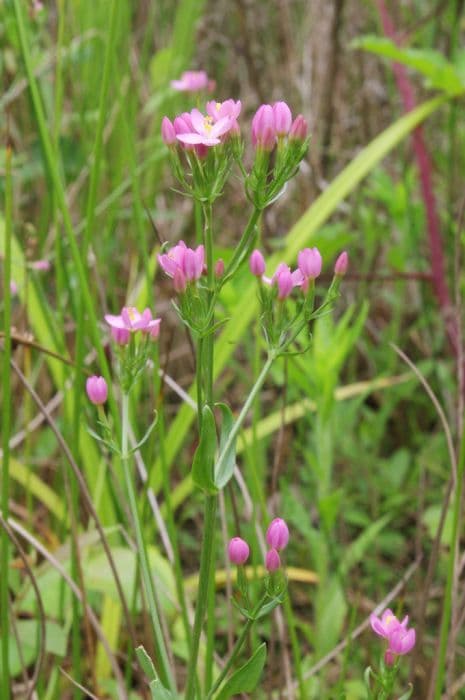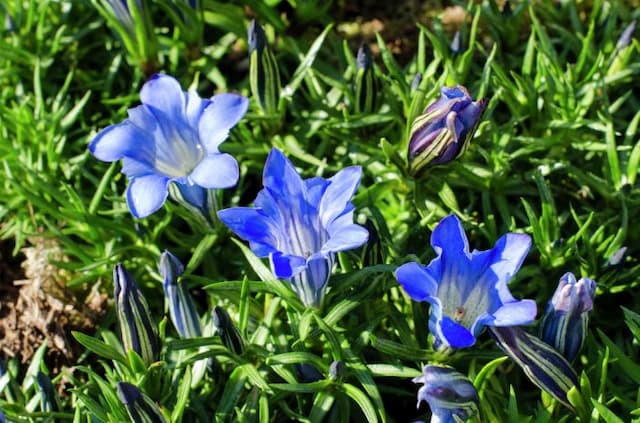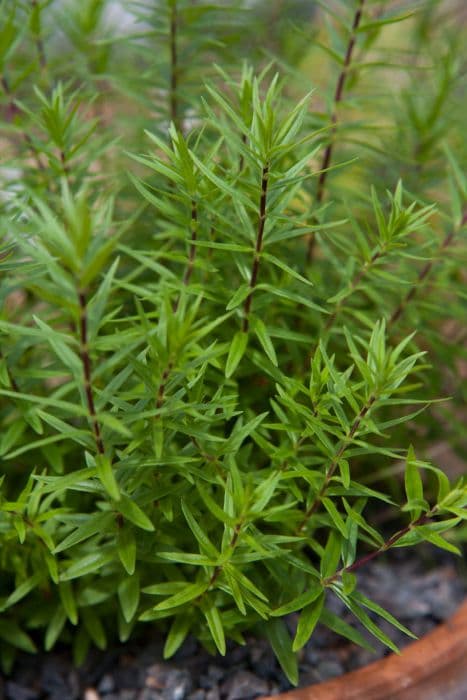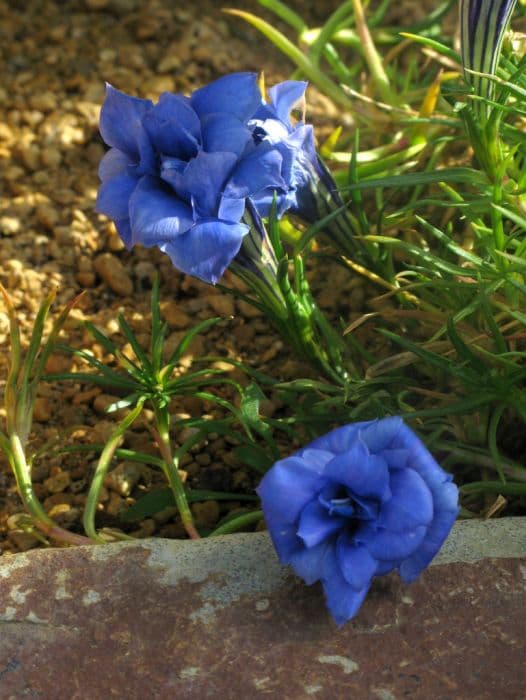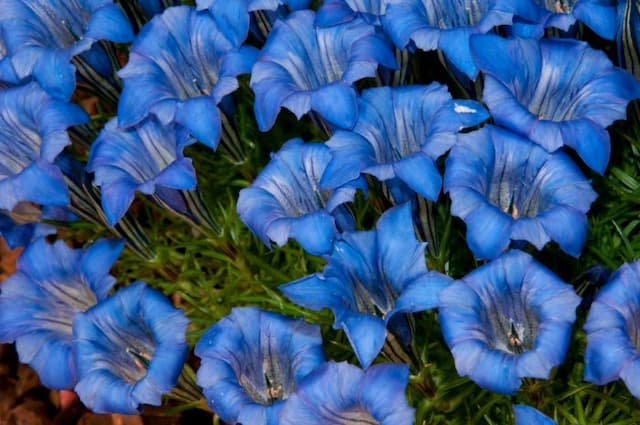Inverleith Gentian Gentiana 'Inverleith'

ABOUT
Gentiana 'Inverleith', commonly known as 'Inverleith' gentian, is a charismatic and striking perennial plant known for its deep blue trumpet-shaped flowers. These vividly colored blooms often have lighter or white striations running up from their bases, creating a beautiful contrast with the darker blue of the petals. The flowers are clustered at the tips of the stems, and they typically have a funnel form that is appealing to various pollinators. The foliage of the 'Inverleith' gentian is lance-shaped with a glossy green color, adding to the overall lush appearance of the plant. The leaves are arranged oppositely on the stem and contribute to the dense habit of this eye-catching perennial. The plant tends to have a neat, clump-forming character that makes it suitable for alpine gardens, rock gardens, borders, or as an accent plant. Its intense blue flowers and vibrant green foliage stand out in the garden, particularly when planted in groups.
About this plant
 Names
NamesSynonyms
Inverleith Gentian
Common names
Gentiana 'Inverleith'
 Toxicity
ToxicityTo humans
Gentians are generally considered non-toxic to humans. There is no widespread documentation of toxicity for Gentiana 'Inverleith', and it is typically safe for human interaction. However, it is always advisable to avoid ingesting any plant material if you are not sure about its edibility and potential effects.
To pets
The gentian species, including Gentiana 'Inverleith', is typically not considered toxic to pets. These plants are not known to cause harmful effects if pets come into contact with or ingest them. However, as with any non-food plant, ingestion in large quantities may potentially cause gastrointestinal upset such as vomiting or diarrhea simply due to the nature of non-digestible plant material.
 Characteristics
CharacteristicsLife cycle
Perennials
Foliage type
Deciduous
Color of leaves
Green
Flower color
Blue
Height
1 feet (30 cm)
Spread
1 feet (30 cm)
Plant type
Herb
Hardiness zones
5
Native area
Europe
Benefits
 General Benefits
General Benefits- Ornamental Appeal: Provides vibrantly colored flowers that enhance the visual appeal of gardens and landscapes.
- Attracts Pollinators: Invites beneficial insects such as bees and butterflies, which are vital for pollination.
- Drought Tolerance: Once established, can tolerate periods of low water, making it suitable for xeriscaping.
- Low Maintenance: Requires minimal care beyond initial establishment, which can save time and effort for gardeners.
- Cold Hardy: Can withstand cold temperatures, making it suitable for planting in various climates.
- Long Blooming Period: Offers a lengthy display of blooms from mid to late summer, providing a sustained period of interest.
- Compact Size: Its moderate growth habit ensures it fits well in smaller gardens or containers without overwhelming the space.
- Deer Resistance: Generally not preferred by deer, which can help prevent damage to the plant and surrounding vegetation.
 Medical Properties
Medical PropertiesThis plant is not used for medical purposes.
 Air-purifying Qualities
Air-purifying QualitiesThis plant is not specifically known for air purifying qualities.
 Other Uses
Other Uses- Gentian 'Inverleith' can be used for creating natural plant dye that imparts beautiful shades of yellow, blue, or green, depending on the mordant used.
- The plant's root system can help in soil stabilization on slopes, preventing erosion in certain landscapes.
- Gentian 'Inverleith' is sometimes incorporated into natural insect repellent formulations due to its unique scent that insects find unappealing.
- Photographers and artists might use the vibrant flowers as subjects or inspiration for their work, contributing to cultural and aesthetic value.
- This plant can play a role in educational gardens or botanical collections, teaching about alpine flora and plant adaptations.
- The flowers can also be used as a gentle natural indicator for pH testing, changing color depending on the acidity of the solution they are placed in.
- Gentian 'Inverleith' can sometimes be part of wildlife gardens as it attracts pollinators like bees and butterflies, aiding in local biodiversity.
- In craft projects, the dried stems and flowers can be used to make bookmarks, pressed flower art, or incorporated into papermaking for decorative effects.
- Culinary enthusiasts may use the flowers as a decorative, non-toxic garnish for salads and desserts, adding an unusual flair to dishes.
- This plant is sometimes used in perfumery, experimenting with its scent to develop new, unique fragrances.
Interesting Facts
 Feng Shui
Feng ShuiThe plant Gentian is not used in Feng Shui practice.
 Zodiac Sign Compitability
Zodiac Sign CompitabilityThe plant Gentian is not used in astrology practice.
 Plant Symbolism
Plant Symbolism- Persistence: The genus name, Gentiana, is derived from Gentius, an Illyrian king who was believed to have discovered the herb's healing properties. Gentiana 'Inverleith' symbolizes a persistent search for wellness and health.
- Victory over hardship: As a hardy plant, Gentiana 'Inverleith' represents overcoming difficulties. It thrives in harsh alpine climates, signifying resilience.
- Splendor and beauty: With its striking deep blue flowers, the plant is often associated with beauty and splendor in the natural world.
- Appreciation for nature: The beauty of Gentiana 'Inverleith' is commonly seen as a symbol of the appreciation and protection of natural habitats, especially given its alpine origins.
 Water
WaterThe Gentian 'Inverleith' prefers consistently moist soil, so water it when the top inch of soil feels dry to the touch, which may equate to approximately once or twice a week, depending on climate conditions. It's important not to let the plant dry out, but also to avoid waterlogging, as this can lead to root rot. Each watering should be thorough, allowing water to penetrate deeply into the soil; typically, this might be around 1 to 2 gallons, depending on the size of the plant and environmental factors like heat and wind. During the growing season in spring and summer, the plant may require more frequent watering, while in cooler months, the need for water diminishes.
 Light
LightThe Gentian 'Inverleith' thrives best in partial shade, where it can receive bright but indirect sunlight. It should be shielded from the harsh afternoon sun to prevent scorching of the leaves. An ideal spot would be one where it gets some morning sun and dappled shade in the afternoon. Ensuring it has the proper balance of light can encourage healthy growth and abundant flowering.
 Temperature
TemperatureThe Gentian 'Inverleith' is tolerant of a range of temperatures but prefers cooler conditions. It can survive minimum temperatures down to about 20 degrees Fahrenheit but thrives best when daytime temperatures are between 50 and 70 degrees Fahrenheit. Prolonged exposure to temperatures above 80 degrees Fahrenheit can stress the plant, so it's important to provide some shade during the hottest parts of the day.
 Pruning
PruningPruning Gentian 'Inverleith' is generally done to remove spent flowers, which encourages further blooming, and to maintain a neat shape. It is best to prune this perennial in the late fall or early spring. Deadheading, or removing faded flowers, can be done throughout the flowering season to keep the plant looking tidy and to potentially extend the blooming period.
 Cleaning
CleaningAs needed
 Soil
SoilThe best soil mix for Gentiana 'Inverleith', commonly known as Gentian, is a well-draining, loamy to sandy mix with added organic matter such as leaf mold or peat. The ideal soil pH for Gentians should be slightly acidic to neutral, ranging from 5.5 to 7.0. Soil should be kept consistently moist but never waterlogged.
 Repotting
RepottingGentian 'Inverleith' usually does not require frequent repotting and can be done every 2-3 years. Spring is the best time to repot this plant, taking care to disturb the roots as little as possible. This ensures the plant has enough time to establish in the new container before winter.
 Humidity & Misting
Humidity & MistingGentian 'Inverleith' thrives best in environments with moderate to high humidity. Aiming for around 50% relative humidity will create ideal conditions for this plant to grow. However, they are quite adaptable and can tolerate lower humidity levels.
 Suitable locations
Suitable locationsIndoor
Provide bright indirect light and cool temperatures.
Outdoor
Plant in partial shade, moist soil, and cool area.
Hardiness zone
3-8 USDA
 Life cycle
Life cycleThe Gentiana 'Inverleith', commonly known as Gentian, begins its life cycle as a seed, dispersed by wind, water, or animals, which germinates in well-draining soil under full to partial sun exposure. Upon germination, the seedling emerges and develops a rosette of leaves at ground level. As the plant matures, it develops a sturdy stem and lance-shaped leaves, along with deep blue to violet trumpet-shaped flowers that typically bloom in late summer to early fall and attract pollinators such as bees and butterflies. Following pollination, the flowers produce small capsule fruits containing numerous tiny seeds. Gentian plants are perennial and will enter a period of dormancy during the winter, re-emerging in the spring from the same root system to begin a new growth cycle. Over time, with the right conditions, the plant can form small clumps, gradually expanding its presence in the garden or natural area.
 Propogation
PropogationPropogation time
Spring to Summer
Gentiana 'Inverleith', commonly known as the Inverleith gentian, is most commonly propagated by seed sowing. For effective germination, it's recommended to stratify the seeds by placing them in a moist substrate within a plastic bag and refrigerating for two to four weeks. Plant the stratified seeds in well-draining soil in the spring, barely covering them with soil. They should be kept lightly moist and in a spot where they can get plenty of light but not direct sunlight. The seeds will typically germinate in two to three weeks. Once the seedlings are a few inches tall and have developed true leaves, they can be transplanted into their final location in the garden.
